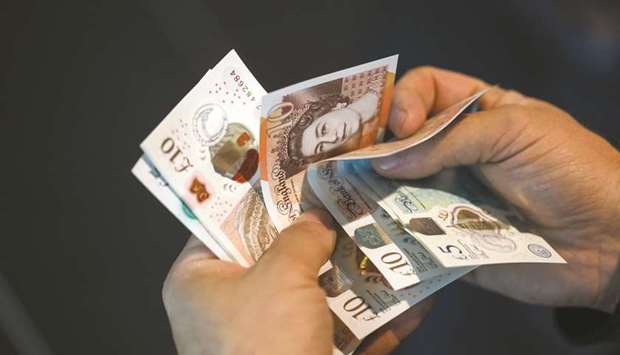The pound is heading for this year’s fourth monthly slide, and a lengthening list of risks is pointing to more turbulence in June.
Sterling traders look set to face heightened uncertainty on multiple fronts next month – the end-June deadline to extend the Brexit transition period, the possibility of negative interest rates in the UK and the economy’s tentative exit from the pandemic lockdown.
That suggests the market will likely break with the trading lull typical for the time of the year, with volatility possibly scaling highs unseen in June since the 2016 Brexit referendum. Sterling has slid almost 3% versus the dollar this month to around $1.2240, falling in May for the 11th year in a row.
“Much uncertainty hangs in the balance around Brexit and the end of June,” said Neil Jones, head of foreign-exchange sales to financial institutions at Mizuho Bank. “Uncertainty generally pushes volatility higher.”
The current Brexit transition period finishes at year-end, which means Britain and the European Union have only until then to forge a new trade deal in order to avoid tariffs and quotas. The other option is to extend the interim period – and the last date to do so is June 30. Talks between negotiators resume on June 1, after this month’s discussions made little progress.
Unwillingness to extend the transition period would leave negotiators with the tall task of cobbling together a trade pact – a process that often runs into years – in a matter of months. That would only heighten concern that the two sides may part ways without an agreement.
Sterling volatility will likely rise on such a prospect as well as any move to extend the transition, albeit not to highs seen during the peak of the pandemic turmoil in March, according to Mizuho’s Jones.
Domestic political noise in the UK could also fuel fluctuations in sterling. Dominic Cummings, Prime Minister Boris Johnson’s most powerful adviser, is under attack over claims he breached lockdown rules. The pound may also see wide fluctuations around the Bank of England’s meeting on June 18. Money markets are already pricing in the prospect of sub-zero UK interest rates by year-end after recent comments by Monetary Policy Committee members suggested the central bank isn’t ruling out the possibility. That prospect sent two-year UK bond yields to a record low below 0% last week.
“Risk managers will be hedging negative rates given they can’t be completely ruled out now, but they remain unlikely to become policy anytime soon with upsizing quantitative easing the preferred option. It’s only until we get a real signal that two-year yields can go a lot more negative, as was the case in Germany”, says Tanvir Sandhu, chief global derivatives strategist at Bloomberg Intelligence.
According to Bloomberg Economics, negative rates probably won’t be a game changer for the economy and a more potent policy mix may be for the BoE to continue with asset purchases, complementing government fiscal stimulus.
“I think an extension to QE is in the price, but negative rates would still increase pressure on pound at this point,” said Jane Foley, a senior foreign currency strategist at Rabobank International. Should the UK become the next major nation with negative interest rates, the pound could also face pressure from the options front, where risk reversals suggest that traders have stayed less bearish compared with the spot market.
The gauge, a barometer of market positioning and sentiment, shows that overall downside risks still prevail for the UK currency. The latest data reveal the depth of the economic damage from the Covid-19 crisis and investors will be on the lookout to assess the impact of the easing restrictions on the rate of the spread of coronavirus in the country.
For Rabobank’s Foley, expectations for pound swings next month should have been higher already as Brexit news is back.
“Given that Brexit tensions look set to rise as well as political pressure on the government over its handling of Covid-19, it is almost inevitable that we will see further volatility and downside pressure on the pound into June,” she said.

A man holds a selection of pound sterling banknotes in an arranged photograph in London. Sterling traders look set to face heightened uncertainty on multiple fronts next month, the end-June deadline to extend the Brexit transition period, the possibility of negative interest rates in the UK and the economy’s tentative exit from the lockdown.


